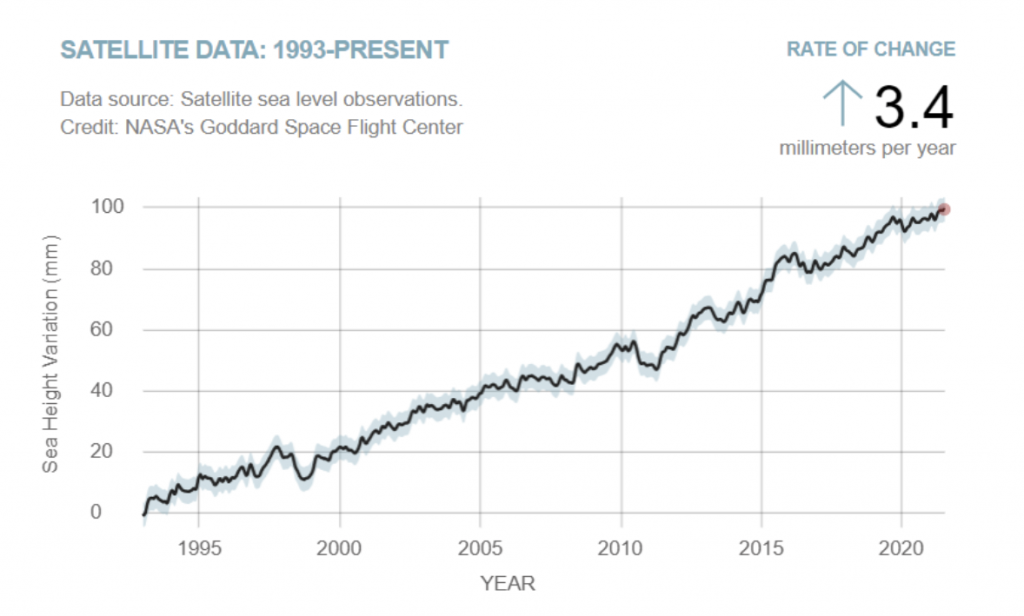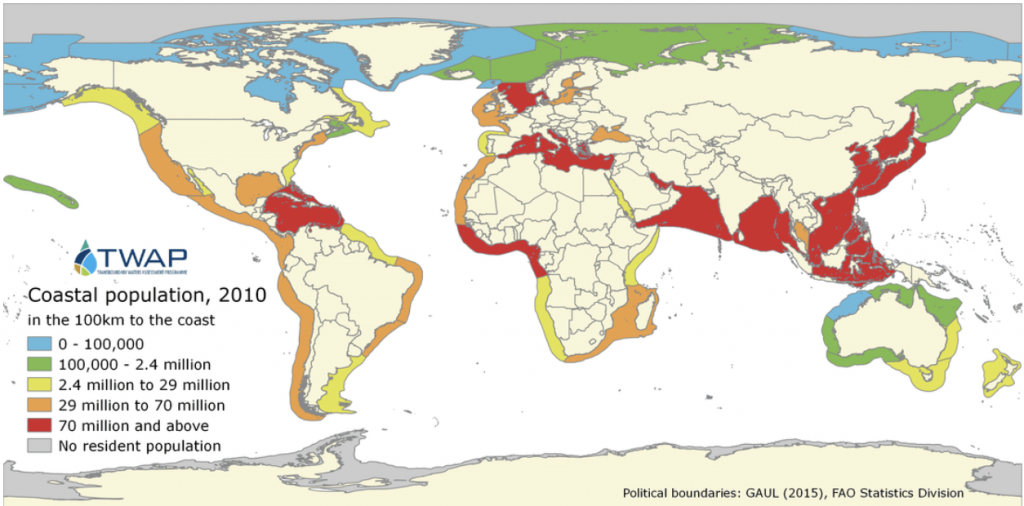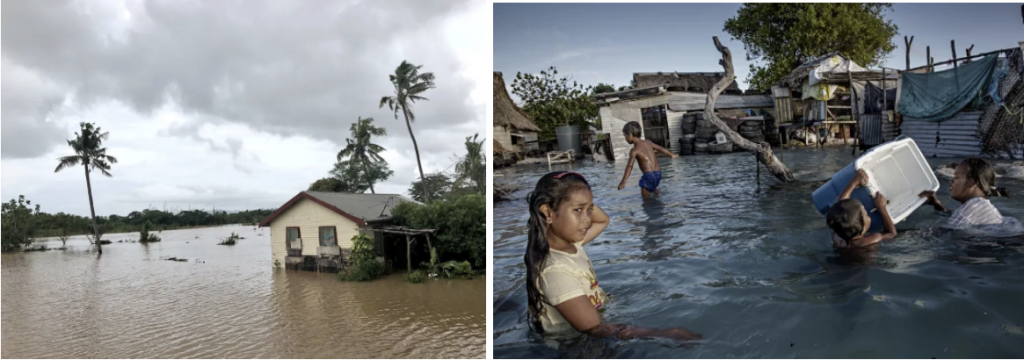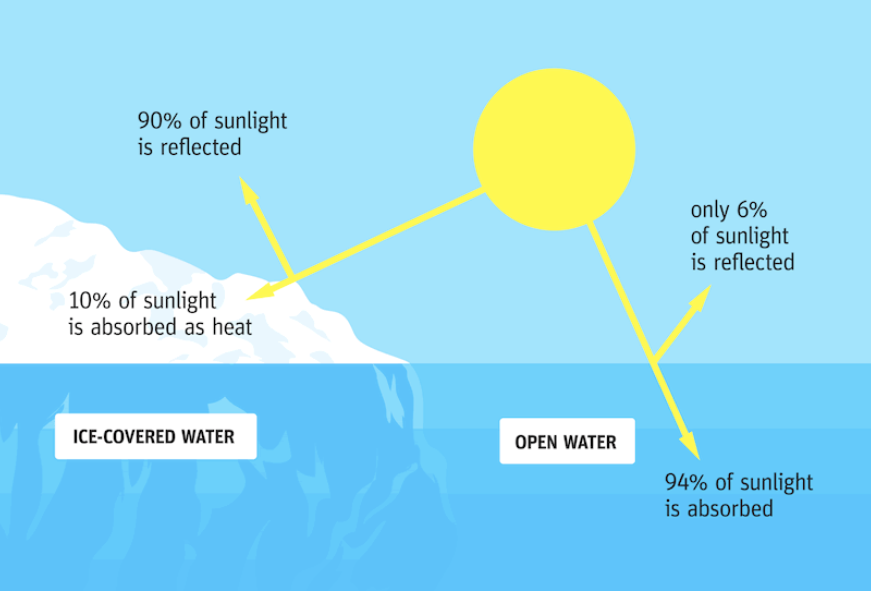What is happening?
- Sea level has been rising steeply since the Industrial Revolution (1760-1840), which the graph below shows. The graph highlights how sea level has risen since 1993 – note that the average rate of change in sea level in 2021 was +3.4 mm/year, while in 1993 it was +1.4 mm/year. This change might seem small, but it makes a huge difference globally over time.

Graph showing time on the horizontal axis and sea level on the vertical axis (from NOAA, 2021).
- Around 40% of the human population around the world currently lives within 100 km of the ocean – think for example of New York City (USA), Tokyo (Japan), and Dhaka (Bangladesh). These coastal communities will be hit first and the hardest by sea level rise (see map below).

Map of global coastal population density. This map shows that coastal areas around the world are commonly densely populated (from the Geographer Online, 2010).
- With ongoing sea level rise, flooding is an increasingly pressing issue. Coastal communities are already experiencing increased tidal flooding and storm surges, which are only expected to worsen with time.
- People living on small, low-lying islands are also severely impacted. Whole island nations such as Tuvalu, Maldives, Palau, Fiji, Kiribati, and the Philippines could be swallowed by sea level rise (pictures below) and their inhabitants are in danger of being displaced and becoming climate refugees.
- Climate change will especially impact poor, Black, and Indigenous people, as well as other people of color, who already suffer due to poverty, racism, and other oppressions. White, wealthy, and Western people will be able to distance themselves from disaster, despite contributing more to carbon emissions that cause climate change.

Images of flooding from tropical cyclone Josie in Fiji, South Pacific Ocean (left; fromThe Independent, 2018), and tidal flooding in Kiribati, Central Pacific Ocean (right; from NBC News, 2021).
How is this related to climate?
- The average global temperature on Earth is increasing and the glaciers in the North and South Poles are melting faster, and less and less ice is refreezing. This is causing the glaciers to recede and slowly disappear.
- The melting of glaciers releases billions of gallons of freshwater into the ocean, causing the global sea levels to increase.
- Sea level rise changes the chemical composition of the ocean. The ocean contains saltwater, but the water melting from glaciers is pure freshwater. This addition of freshwater to the oceans disturbs the density of ocean water. This can trigger changes in global ocean current patterns, which are profoundly important to all ecosystems on Earth.
- Sea level rise is caused by climate change, but it is also causing climate change to worsen. The melting of glaciers is creating a positive feedback loop. Glaciers are white, so they reflect sunlight away from the Earth, but as they melt, more sunlight is absorbed by the Earth’s surface. This process increases warming, which leads to ice continuing to melt. This process is pictured below.

Diagram illustrating how melting glaciers affect climate change (from Exploratorium).
References and additional resources
- Cockburn H. “Fiji’s existence threatened by “frightening new era” of deadly climate change.” The Independent. 2018. https://www.independent.co.uk/climate-change/news/fiji-islands-climate-change-sea-level-rise-global-warming-cyclone-josie-a8286511.html.
- “Global Climate Change Explorer: Ice.” Exploratorium. 2021. https://www.exploratorium.edu/climate/ice.
- Heath S., “Crowded Coasts.” The Geographer Online, 2010. https://www.thegeographeronline.net/crowded-coasts.html.
- Lindsey R. “Climate Change: Global Sea Level.” NOAA. 2021. https://www.climate.gov/news-features/understanding-climate/climate-change-global-sea-level.
- “Sea Level.” NASA. July 2021. https://climate.nasa.gov/vital-signs/sea-level/.
- Smith P. “Climate change, rising seas may lead to extinction of small island nations.” NBC News. 2021. https://www.nbcnews.com/news/world/climate-change-rising-seas-may-lead-extinction-small-island-nations-n1276394.
- The Ocean Conference. “Factsheet: People and Oceans.” the UN. 2017. https://www.un.org/sustainabledevelopment/wp-content/uploads/2017/05/Ocean-fact-sheet-package.pdf.
- “The Study of Earth as an Integrated System.” NASA. 2021. https://climate.nasa.gov/nasa_science/science/#:~:text=As%20the%20atmosphere%20warms%20and,a%20very%20strong%20positive%20feedback.
- “20 Islands that could Disappear in your Lifetime.” USA Today. 2019. https://www.usatoday.com/picture-gallery/travel/destinations/2019/11/29/climate-change-endangered-islands-disappearing-fiji-maldives-alaska/40630403/.
